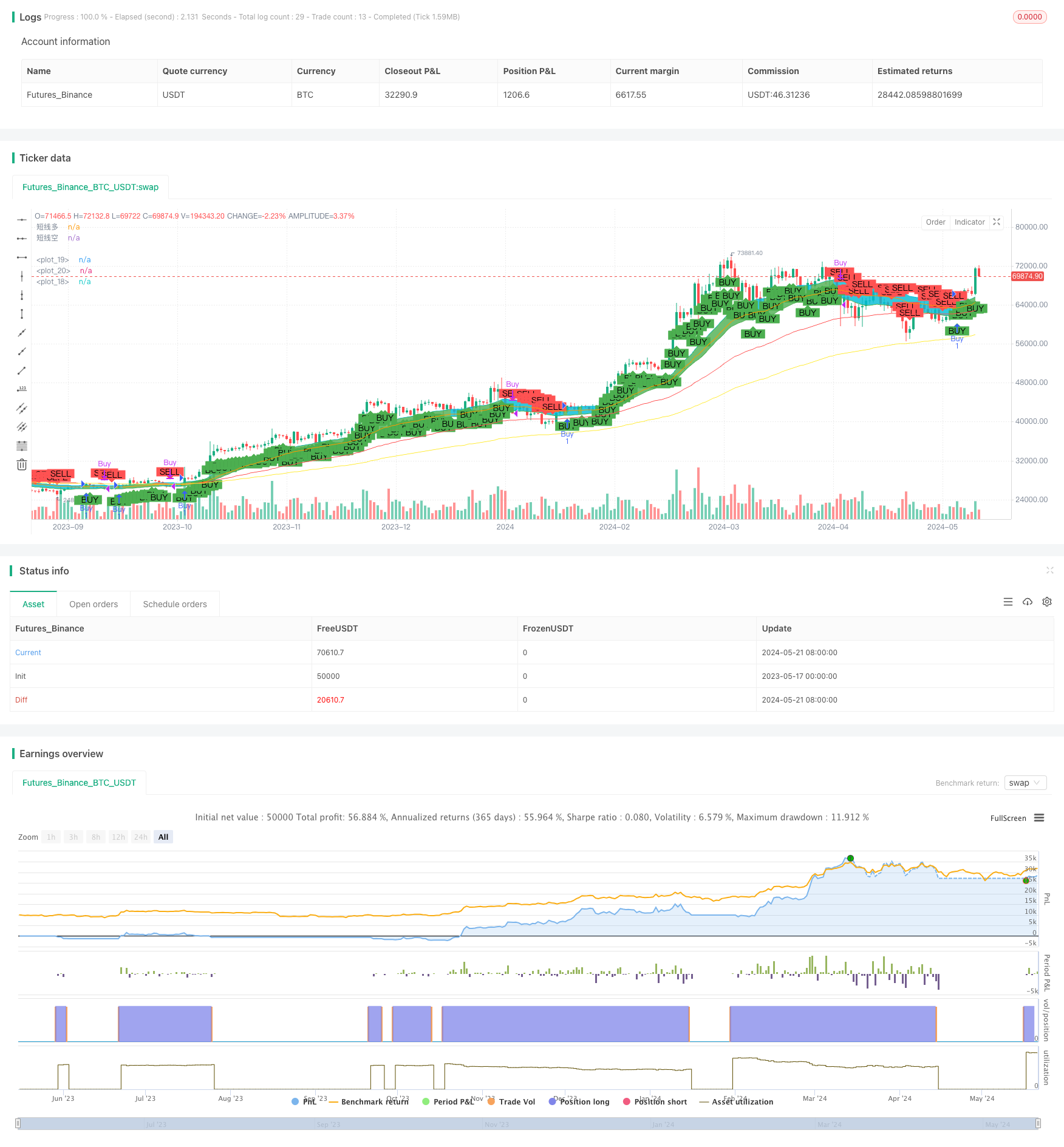
概述
该策略使用三条不同周期的EMA均线(144日、34日和76日)来捕捉市场的中长期趋势,同时结合30日最高价和最低价的EMA均线作为短期多空信号,当收盘价突破短期多方信号时开多仓,突破短期空方信号时平仓。这种方法可以在把握市场主要趋势的同时,利用短期信号实现较为灵活的仓位管理。
策略原理
- 计算144日、34日和76日的EMA均线,分别代表超长期、中期和长期趋势。
- 计算30日最高价和最低价的EMA均线,分别作为短期多头和空头信号。
- 当收盘价突破30日最高价EMA均线时,开多仓;当收盘价跌破30日最低价EMA均线时,平仓。
- 在图表上绘制EMA均线以及短期多空信号区间,直观显示市场趋势和信号。
策略优势
- 结合不同周期的EMA均线,可以全面把握市场的超长期、长期和中期趋势。
- 利用30日最高价和最低价的EMA均线作为短期信号,可以在趋势中实现灵活的仓位管理,提高资金利用效率。
- 图表上清晰绘制各种信号和趋势,便于交易者直观判断市场状况。
策略风险
- EMA均线存在一定的滞后性,可能在市场转折点反应较慢。
- 短期信号受市场波动影响较大,可能出现频繁的开平仓操作,增加交易成本。
- 策略缺乏止损措施,在市场出现剧烈波动时可能承担较大风险。
策略优化方向
- 引入更多不同周期的EMA均线,如200日、50日等,丰富趋势判断维度。
- 优化短期信号的参数,如调整最高价和最低价EMA均线的周期,以更好地适应不同市场状况。
- 加入止损机制,如根据ATR设置动态止损位,以控制单笔交易的最大风险。
- 考虑加入移动止盈或trilling stop等方法,以更好地保护已有利润。
总结
EMA均线交叉与短期信号策略通过多周期EMA均线把握市场趋势,并利用短期价格信号实现灵活的仓位管理,是一种趋势跟踪与波段操作相结合的方法。但该策略也存在滞后、频繁交易和缺乏风控等问题,需要进一步优化以提升其稳健性和盈利能力。通过引入更多维度的趋势判断、动态调整信号参数、加入合理的止损止盈机制等方法,可以使该策略更加完善和可靠。
策略源码
/*backtest
start: 2023-05-17 00:00:00
end: 2024-05-22 00:00:00
period: 1d
basePeriod: 1h
exchanges: [{"eid":"Futures_Binance","currency":"BTC_USDT"}]
*/
//@version=5
strategy("EMA Crossover with Short-term Signals", overlay=true)
// 定义EMA
shortest = ta.ema(close, 144)
short = ta.ema(close, 34)
longer = ta.ema(close, 76)
// 绘制EMA
plot(shortest, color=color.new(color.yellow, 0))
plot(short, color=color.new(color.orange, 0))
plot(longer, color=color.new(color.red, 0))
// 定义短线多空信号的EMA
stLong = ta.ema(high, 30)
stShort = ta.ema(low, 30)
stLongPlot = plot(stLong, '短线多', color.new(color.aqua, 0))
stShortPlot = plot(stShort, '短线空', color.new(color.green, 0))
// 绘制短线多空信号
clr = close > stLong ? color.green : color.aqua
fill(stLongPlot, stShortPlot, color=clr, transp=90)
// 交易信号
if (close > stLong)
strategy.entry("Buy", strategy.long)
if (close < stShort)
strategy.close("Buy")
// 显示买卖信号
plotshape(series=close > stLong, title="Buy Signal", location=location.belowbar, color=color.green, style=shape.labelup, text="BUY")
plotshape(series=close < stShort, title="Sell Signal", location=location.abovebar, color=color.red, style=shape.labeldown, text="SELL")
相关推荐